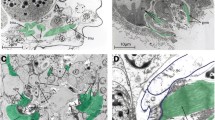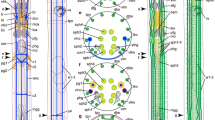Abstract
The somatic muscular systems of two species of Seisonacea (Rotifera), Seison nebaliae and Paraseison annulatus, are described using fluorescently labelled phalloidin in combination with confocal laser scanning microscopy. Their overall muscular arrangement is similar and consists of segmentally organised longitudinal fibres that extend the length of the body and are surrounded by semi-circular (= incomplete) bands. However, differences in the musculature between the two species are present and possibly reflect specific adaptations in feeding strategy and locomotion related to the occupation of individual niches on their host, the leptostracan crustacean N. bipes. For example, S. nebaliae has semi-circular muscles in the head region only, while P. annulatus possesses incomplete circular muscles also in the trunk region; furthermore, there are also differences in the arrangements and number of longitudinal muscles. The muscular systems of all rotifer species examined so far are compared in order to establish the ground pattern of the last putative ancestor as well as to seek for traits of systematic importance. Results from both species corroborate earlier hypotheses on the arrangement of muscles in the putative common ancestor of Rotifera, which suggested an orthogonal arrangement consisting of a series of probably continuous (not segmental) inner longitudinal muscles, surrounded by semi-circular fibres, ventrally opened. However, significant morphological and ecological variations among taxa investigated so far show that a consistent correlation between muscular traits and specific ecological features and/or phylogeny is still far from being clear. Hence, musculature of additional taxa, representing the systematic width and occupying a diverse range of habitats, should be investigated.




Similar content being viewed by others
References
Ahlrichs WH (1995a) Ultrastruktur und Phylogenie von Seison nebaliae (Grube 1859) und Seison annulatus (Claus 1876). Cuvillier Verlag, Göttingen
Ahlrichs WH (1995b) Seison annulatus und Seison nebaliae—Ultrastruktur und Phylogenie. Verhandlungen der Deutschen Zoologischen Gesellschaft 88:155
Ahlrichs WH (1997) Epidermal ultrastructure of Seison nebaliae and Seison annulatus, and a comparison of epidermal structures within Gnathifera. Zoomorphology 117:41–48
Ahlrichs WH (1998) Spermatogenesis and ultrastructure of the spermatozoa of Seison nebaliae (Syndermata). Zoomorphology 118:255–261
Fontaneto D, Jondelius U (2011) Broad taxonomic sampling of mitochondrial cytochrome c oxidase subunit I does not solve the relationships between Rotifera and Acanthocephala. Zool Anz 250:80–85
Fussmann GF (2011) Rotifers: excellent subjects for the study of macro- and microevolutionary change. Hydrobiologia 662:11–18
García-Varela M, Nadler SA (2006) Phylogenetic relationships among Syndermata inferred from nuclear and mitochondrial gene sequences. Mol Phyl Evol 40:61–72
Garey JR, Near TJ, Nonnemacher MR, Nadler SA (1996) Molecular evidence for Acanthocephala as a subtaxon of Rotifera. J Mol Evol 43:287–292
Herlyn H, Piskurek O, Schmitz J, Ehlers U, Zischler H (2003) The syndermatan phylogeny and the evolution of acanthocephalan endoparasitism as inferred from 18S rDNA sequences. Mol Phyl Evol 26:155–164
Hochberg R, Graham L (2010) Neuromuscular organization of the freshwater colonial rotifer, Sinantherina socialis, and its implications for understanding the evolution of coloniality in Rotifera. Zoomorphology 129:153–162
Hochberg R, Gurbuz OA (2007) Functional morphology of somatic muscles and anterolateral setae in Filinia novaezealandiae Shiel and Sanoamuang, 1993 (Rotifera). Zool. Anz. 246:11–22
Hochberg R, Gurbuz OA (2008) Comparative morphology of the somatic musculature in species of Hexarthra and Polyarthra (Rotifera, Monogononta): its function in appendage movement and escape behavior. Zool. Anz. 247:233–248
Hochberg R, Litvaitis MK (2000) Functional morphology of the muscles in Philodina sp. (Rotifera: Bdelloidea). Hydrobiologia 432:57–64
Hochberg R, Litvaitis MK (2001) The musculature of Draculiciteria tesselata: implications for the evolution of dorso-ventral muscles in Gastrotricha. Hydrobiologia 452:155–161
Hochberg R, O’Brien S, Puleo A (2010) Behavior, metamorphosis, and muscular organization of the predatory rotifer Acyclus inquietus (Rotifera, Monogononta). Inv. Biol. 29:210–219
Hyman LH (1951) The invertebrates: acanthocephala, aschelminthes, and entoprocta. The pseudocoelomate Bilateria, Vol. 3. McGraw-Hill Inc, New York
Illgen H (1916) Zur Kenntnis der Biologie und Anatomie der parasitischen Rotatorien-Familie der Seisoniden. Zool Anz 47:1–9
Kajihara H, Gibson R, Mawatari SF (2001) A new genus and species of monostiliferous hoplonemertean (Nemertea: Enopla: Monostilifera). Hydrobiologia 456:187–198
Koste W (1975) Das Rädertier-Porträt. Seison annulatus, ein Ektoparasit des marinen Krebses Nebalia. Mikrokosmos 64:341–347
Kotikova EA, Raikova OI, Flyatchinskaya LP, Reuter M, Gustafsson MKS (2001) Rotifer muscles as revealed by phalloidin-TRITC staining and confocal scanning laser microscopy. Acta Zool 82:1–9
Kotikova EA, Raikova OI, Reuter M, Gustafsson MKS (2004) Musculature of an illoricate rotifer Asplanchnopus multiceps as revealed by phalloidin fluorescence and confocal microscopy. Tissue Cell 36:189–195
Kotikova EA, Raikova OI, Flyatchinskaya LP (2006) Study of architectonics of rotifer musculature by the method of fluorescence with use of confocal microscopy. J Evol Biochem Physiol 42:88–97
Leasi F, Ricci C (2010) Musculature of two bdelloid rotifers, Macrotrachela quadricornifera and Adineta ricciae: organisation and locomotion in a functional and evolutionary perspective. J Zool Syst Evol Res 48:33–39
Leasi F, Todaro MA (2009) Meiofaunal cryptic species revealed by confocal microscopy: the case of Xenotrichula intermedia (Gastrotricha). Mar Biol 156:1335–1346
Leasi F, Fontaneto D, Melone G (2010) Phylogenetic constraints in the muscular system of rotifer males. Investigation on the musculature of males versus females of Brachionus manjavacas and Epiphanes senta (Rotifera, Monogononta). J Zool 282:109–119
Leasi F, Rouse GW, Sørensen MV (2011) A new species of Paraseison (Rotifera: Seisonacea) from the coast of California, USA. J Mar Biol Ass UK. doi:10.1017/S0025315411000129
Mark Welch DB (2000) Evidence from a protein-coding gene that acanthocephalans are rotifers. Inv Biol 119:17–26
Miller DM, Dunagan TT (1985) Functional morphology. In: Crompton DWT, Nickol BB (eds) Biology of the Acanthocephala. Cambridge University press, Cambridge, pp 73–123
Remane A (1929–1933) Rotatoria. In: Bronn HG (ed) Klassen und Ordnungen des Tier-Reichs, Vol. 4, Vermes. Akademische Verlagsgesellschaft mbH, Leipzig, pp 1–576
Ricci C, Fontaneto D (2009) The importance of being a bdelloid: Ecological and evolutionary consequences of dormancy. Ital J Zool 76:240–249
Ricci C, Melone G, Sotgia C (1993) Old and new data on Seisonidea (Rotifera). Hydrobiologia 255(256):495–511
Riemann O, Martinez Arbizu P, Kieneke A (2008) Organisation of body musculature in Encentrum mucronatum Wulfert, 1936, Dicranophorus forcipatus (O.F. Müller, 1786) and in the ground pattern of Ploima (Rotifera: Monogononta). Zool Anz 247:133–145
Santo N, Fontaneto D, Fascio U, Melone G, Caprioli M (2005) External morphology and muscle arrangement of Brachionus urceolaris, Floscularia ringens, Hexarthra mira and Notommata glyphura (Rotifera, Monogononta). Hydrobiologia 546:223–229
Segers H, Melone G (1998) A comparative study of the trophi morphology in Seisonidea (Rotifera). J Zool 244:201–207
Segers H, De Smet WH, Fischer C, Fontaneto D, Michaloudi E, Wallace RL, Jersabek CD (2012) Towards a list of available names in zoology, partim phylum Rotifera. Zootaxa 3179:61–68
Sørensen MV (2002) On the evolution and morphology of the rotiferan trophi, with a cladistic analysis of Rotifera. J Zool Syst Evol Res 40:129–154
Sørensen MV (2005a) Musculature in three species of Proales (Monogononta, Rotifera) stained with phalloidin-linked fluorescent dye. Zoomorphology 124:47–55
Sørensen MV (2005b) Musculature of Testudinella patina (Rotifera: Flosculariacea), revealed with CLSM. Hydrobiologia 546:231–238
Sørensen MV, Giribet G (2006) A modern approach to rotiferan phylogeny: combining morphological and molecular data. Mol Phyl Evol 40:585–608
Sørensen MV, Funch P, Hooge M, Tyler S (2003) Musculature of Notholca acuminata (Rotifera: Ploima: Brachionidae) revealed by confocal scanning laser microscopy. Inv Biol 122:223–230
Sørensen MV, Segers H, Funch P (2005) On a new Seison Grube, 1861 from the coastal waters of Kenya, with a reappraisal of the classification of the Seisonida (Rotifera). Zool Stud 44:34–43
Wilts EF, Ahlrichs WH, Arbizu PM (2009) The somatic musculature of Bryceella stylata (Milne, 1886) (Rotifera: Proalidae) as revealed by confocal laser scanning microscopy with additional new data on its trophi and overall morphology. Zool Anz 248:161–175
Zrzavý J (2001) The interrelationships of metazoan parasites: a review of phylum- and higher-level hypotheses from recent morphological and molecular phylogenetic analyses. Folia Parasit 48:81–103
Acknowledgments
We are grateful to Gilles Maron and Andreas Hejnol for their crucial help during field collection. Significant and improving comments on an early version of the manuscript by A. Hejnol and Diego Fontaneto were very much appreciated. The authors would like to thank Birgen H. Rothe, other two anonymous reviewers and the editor Thomas Bartolomaeus for their valuable comments and suggestions to improve the quality of the paper. Funding to support the collection in Roscoff was provided by EU programme ASSEMBLE—grant agreement no. 227799, while Encyclopedia of Life (Rubenstein Fellow 2011), Systematics Association (Systematics Research Fund 2011) and Accademia Nazionale dei Lincei (Royal Society Fellowship 2011) supported FL for her research.
Author information
Authors and Affiliations
Corresponding author
Additional information
Communicated by T. Bartolomaeus.
Rights and permissions
About this article
Cite this article
Leasi, F., Neves, R.C., Worsaae, K. et al. Musculature of Seison nebaliae Grube, 1861 and Paraseison annulatus (Claus, 1876) revealed with CLSM: a comparative study of the gnathiferan key taxon Seisonacea (Rotifera). Zoomorphology 131, 185–195 (2012). https://doi.org/10.1007/s00435-012-0155-2
Received:
Revised:
Accepted:
Published:
Issue Date:
DOI: https://doi.org/10.1007/s00435-012-0155-2




